Sony Xperia Tablet Z SGP311, Xperia Tablet Z SGP312 User Guide

User guide
Xperia™ Tablet Z
SGP311/SGP312
Contents
Getting started............................................................................... |
6 |
About this User Guide......................................................................... |
6 |
Device overview.................................................................................. |
6 |
Assembly............................................................................................ |
7 |
Starting your device for the first time................................................... |
8 |
Why Do I Need a Google™ Account?................................................. |
8 |
Charging your Device.......................................................................... |
9 |
Learning the basics...................................................................... |
10 |
Using the touchscreen...................................................................... |
10 |
Locking and Unlocking the Screen.................................................... |
11 |
Home screen.................................................................................... |
12 |
Application screen............................................................................. |
13 |
Navigating Applications..................................................................... |
14 |
Small apps........................................................................................ |
14 |
Widgets............................................................................................ |
15 |
Shortcuts and folders........................................................................ |
16 |
Background and Themes.................................................................. |
16 |
Battery and power management....................................................... |
17 |
Taking a screenshot.......................................................................... |
18 |
Notifications...................................................................................... |
18 |
Icons in the status bar....................................................................... |
20 |
Application Overview......................................................................... |
22 |
Downloading applications............................................................ |
24 |
Downloading applications from Google Play™.................................. |
24 |
Downloading applications from other sources................................... |
24 |
Internet and networks.................................................................. |
25 |
Browsing the web............................................................................. |
25 |
Wi-Fi® ............................................................................................. |
25 |
Virtual private networks (VPNs).......................................................... |
26 |
Synchronizing data on your device.............................................. |
28 |
Synchronizing with Online Accounts.................................................. |
28 |
Synchronizing with Microsoft® Exchange ActiveSync® ..................... |
28 |
Synchronizing with Outlook® using a computer................................ |
29 |
Basic settings............................................................................... |
30 |
Accessing settings............................................................................ |
30 |
Sound Volume ................................................................................. |
30 |
Screen settings................................................................................. |
32 |
Daydream......................................................................................... |
33 |
Screen lock....................................................................................... |
33 |
2 |
|
This is an Internet version of this publication. © Print only for private use.
Unlocking Your Device Automatically................................................. |
34 |
Language settings............................................................................. |
38 |
Date and time................................................................................... |
38 |
Mobile BRAVIA® Engine................................................................... |
38 |
Enhancing the sound output............................................................. |
38 |
Multiple User Accounts..................................................................... |
39 |
Typing text................................................................................... |
42 |
On-Screen Keyboard........................................................................ |
42 |
Entering text using voice input........................................................... |
43 |
Editing text........................................................................................ |
43 |
Personalizing the On-Screen Keyboard............................................. |
44 |
Contacts ...................................................................................... |
46 |
Transferring contacts........................................................................ |
46 |
Searching and viewing contacts........................................................ |
47 |
Adding and editing contacts.............................................................. |
48 |
Favorites and groups........................................................................ |
48 |
Sending contact information.............................................................. |
49 |
Avoiding duplicate entries in the Contacts application....................... |
49 |
Backing Up Contacts........................................................................ |
49 |
Email............................................................................................. |
51 |
Setting up email................................................................................ |
51 |
Sending and Receiving Email Messages........................................... |
51 |
Organizing your email messages....................................................... |
52 |
Email account settings...................................................................... |
53 |
Gmail™............................................................................................. |
53 |
Music ........................................................................................... |
55 |
Transferring Music to Your Device .................................................... |
55 |
Listening to music............................................................................. |
55 |
Music Homescreen Menu................................................................. |
56 |
Playlists............................................................................................. |
57 |
Sharing music................................................................................... |
58 |
Enhancing the sound........................................................................ |
58 |
Visualizer .......................................................................................... |
58 |
Recognizing music with TrackID™.................................................... |
59 |
FM radio....................................................................................... |
61 |
Listening to the Radio....................................................................... |
61 |
Favorite radio channels..................................................................... |
62 |
Sound settings.................................................................................. |
62 |
Camera......................................................................................... |
63 |
Camera Controls Overview................................................................ |
63 |
Face detection.................................................................................. |
64 |
Using Smile Shutter™ to capture smiling faces................................. |
64 |
3 |
|
This is an Internet version of this publication. © Print only for private use.
Adding the geographical position to your photos............................... |
65 |
General camera settings................................................................... |
65 |
Still camera settings.......................................................................... |
67 |
Video camera settings....................................................................... |
70 |
Photos and videos in Album........................................................ |
73 |
Viewing Photos and Videos............................................................... |
73 |
Sharing and Managing Photos and Videos........................................ |
74 |
Editing photos with the Photo editor application................................ |
75 |
Editing videos with the Movie Creator application.............................. |
76 |
Hiding photos and videos.................................................................. |
76 |
Album Homescreen Menu................................................................. |
77 |
Viewing your photos on a map.......................................................... |
78 |
Videos.......................................................................................... |
80 |
Watching videos in the Video application........................................... |
80 |
Transferring Video Content to Your Device ....................................... |
81 |
Managing video content.................................................................... |
81 |
Movie Creator................................................................................... |
81 |
PS Video Service............................................................................... |
82 |
Connectivity................................................................................. |
83 |
Mirroring the Screen of Your Device on a TV Using a Cable.............. |
83 |
Mirroring the screen of your device wirelessly on a TV....................... |
83 |
Sharing Content with DLNA Certified™ Devices................................ |
84 |
Connecting Your Device to USB Accessories.................................... |
86 |
Connecting Your Device to a DUALSHOCK™ Series Wireless |
|
Controller.......................................................................................... |
87 |
NFC.................................................................................................. |
87 |
Bluetooth® Wireless Technology...................................................... |
89 |
One-Touch Setup............................................................................. |
91 |
Smart apps and features that save you time............................... |
92 |
Controlling Accessories and Settings with Smart Connect™............. |
92 |
Using your device as a wallet............................................................ |
93 |
Travel and maps........................................................................... |
95 |
Using location services...................................................................... |
95 |
Google Maps™ and navigation......................................................... |
95 |
Airplane mode................................................................................... |
95 |
Calendar and alarm clock............................................................ |
97 |
Calendar........................................................................................... |
97 |
Alarm and Clock............................................................................... |
98 |
Accessibility............................................................................... |
100 |
Magnification Gestures.................................................................... |
100 |
Large Text....................................................................................... |
100 |
Color Correction.............................................................................. |
100 |
4 |
|
This is an Internet version of this publication. © Print only for private use.
TalkBack......................................................................................... |
100 |
Support and maintenance.......................................................... |
102 |
Support for your device................................................................... |
102 |
Computer tools............................................................................... |
102 |
Updating Your Device..................................................................... |
103 |
Finding a Lost Device ..................................................................... |
104 |
Finding the identification number of your device.............................. |
105 |
Memory and Storage...................................................................... |
105 |
Managing files using a computer..................................................... |
107 |
Backing Up and Restoring Content................................................. |
108 |
Resetting Your Applications............................................................ |
109 |
Restarting and resetting your device............................................... |
110 |
Using Your Device in Wet and Dusty Conditions.............................. |
111 |
Recycling your device..................................................................... |
112 |
Limitations to services and features................................................. |
112 |
Legal information............................................................................. |
112 |
5
This is an Internet version of this publication. © Print only for private use.
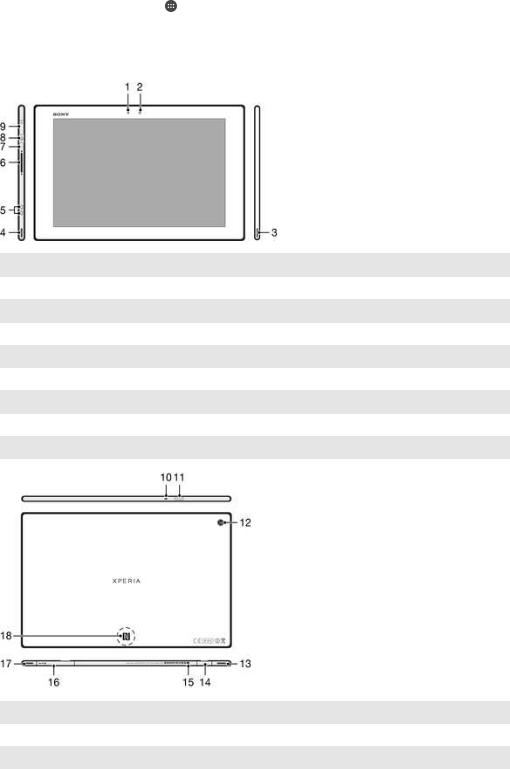
Getting started
About this User Guide
This is the Xperia™ Tablet Z User guide for the Android™ 5.1 software version. If you' re not sure which software version your device is running, you can check it via the Settings menu. For more information about software updates, see Updating Your Device on
the 103 page.
To check the current software version of your device
1 |
From your Homescreen, tap . |
2 |
Find and tap Settings > About tablet > Android™ version. |
Device overview
1 Light sensor
2 Front camera
3 Speaker A
4Speaker B
5 Charging dock connector
6Volume key
7 Notification light
8 Power key
9Headset jack
10Microphone
11Infrared sensor
12Main camera
6
This is an Internet version of this publication. © Print only for private use.
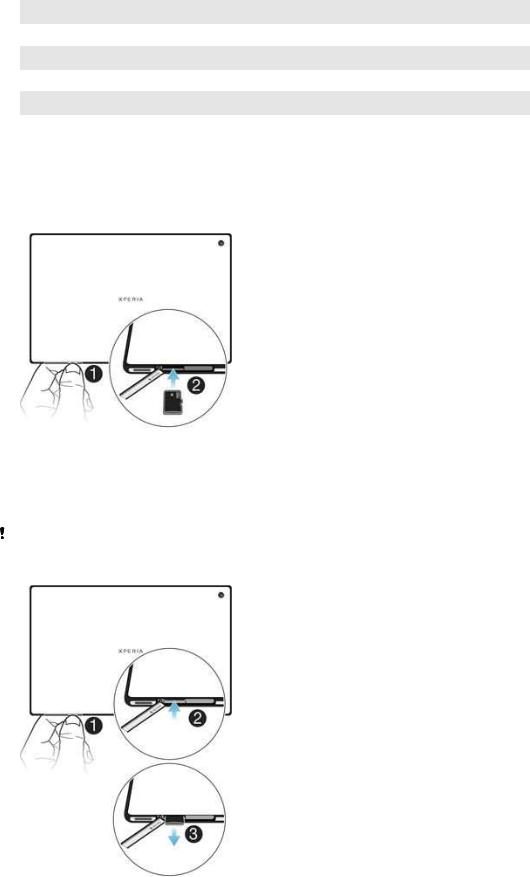
13Speaker B (same as 4)
14Port for charger/USB cable
15Hole for attaching the charger port cover
16Memory card slot
17Speaker A (same as 3)
18NFC™ detection area
Assembly
A protective plastic sheet is attached to the screen. You should peel off this sheet before using the touchscreen. Otherwise, the touchscreen might not function properly.
To insert the memory card
1Insert a fingernail into the gap between the memory card cover and the bottom side of the device, then detach the memory card cover.
2Place the memory card in the memory card slot, with the gold-colored contacts facing down, then push the memory card all the way into the slot until you hear a locking sound.
3Reattach the memory card cover.
The memory card may not be included at purchase in all markets.
To remove the memory card
7
This is an Internet version of this publication. © Print only for private use.
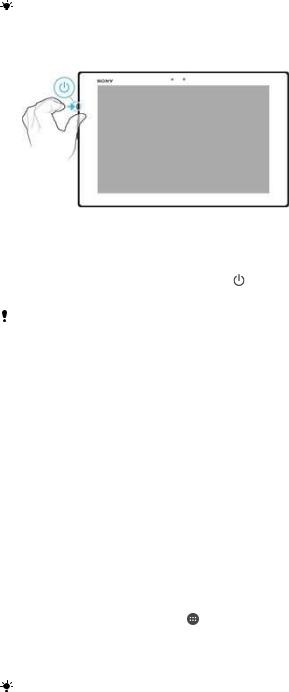
1Turn off the device.
2Remove the cover of the memory card slot, then press against the edge of the memory card and release it.
3Draw the card outwards to remove it fully.
Starting your device for the first time
The first time you start your device, a setup guide opens to help you configure basic settings, sign in to online accounts, and personalize your device. For example, if you have a Sony Entertainment Network account, you can sign in to it here and get set up straight away.
You can also access the setup guide later from the Settings menu. To access the setup guide on a device with multiple users, you must be logged in as the owner, that is, the primary user.
To Turn on the Device
1Press and hold down the power key  until the screen flashes.
until the screen flashes.
2Wait a while for the device to start.
|
To Turn off the Device |
1 |
Press and hold down the power key until the options menu opens. |
2 |
In the options menu, tap Power off. |
|
It may take a while for the device to shut down. |
Why Do I Need a Google™ Account?
|
Your Xperia™ device from Sony runs on the Android™ platform developed by Google™. |
|
A range of Google™ applications and services is available on your device when you |
|
purchase it, like Gmail™, Google Maps™, YouTube™, and the Play Store™ application, |
|
which gives you access to the Google Play™ online store for downloading Android™ |
|
applications. To get the most out of these services, you need a Google™ account. For |
|
example, a Google™ account is mandatory if you want to: |
• |
Download and install applications from Google Play™. |
• |
Synchronize email, contacts, and the calendar. |
• |
Chat with friends using the Hangouts™ application. |
• |
Synchronize your browsing history and bookmarks. |
|
For more information about Android™ and Google™, go to |
|
www.sonymobile.com/support. |
|
To Set up a Google™ Account on Your Device |
1 |
From your Homescreen, tap . |
2Find and tap Settings > Accounts > Add account > Google.
3Follow the registration wizard to create a Google™ account, or sign in if you already have an account.
You can also sign in to or create a Google™ account from the setup guide the first time you start your device. Or you can go online and create an account at www.google.com/accounts.
8
This is an Internet version of this publication. © Print only for private use.
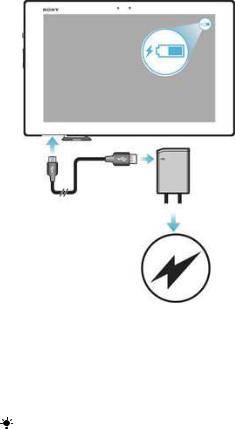
Charging your Device
Your device has an embedded, rechargeable battery that should be replaced only by Sony or an authorized Sony repair center. You should never try to open or take apart this device yourself. Opening the device can cause damage that will void your warranty.
The battery is partly charged when the device is shipped from the factory. The battery level may be very low, depending on how long the device was in the box before you purchased it. It is therefore recommended that you charge the battery for at least 30 minutes before starting up your device for the first time. You can still use your device while it is charging. Read more about how to improve battery performance in Battery and power management on page 17 .
To charge your device
1Plug the charger into a power outlet.
2Plug one end of the USB cable into the charger (or into the USB port of a computer).
3Plug the other end of the cable into the micro USB port on your device, with the USB symbol facing up. The notification light illuminates when charging begins.
4When the device is fully charged, disconnect the cable from your device by pulling it straight outward. Make sure not to bend the connector.
If the battery is completely discharged, it may take a few minutes before the notification light illuminates and the charging icon  appears.
appears.
Battery notification light status
Green |
The battery is charging and the battery charge level is greater than 90% |
|
|
Red |
The battery is charging and the battery charge level is less than 15% |
|
|
Orange |
The battery is charging and the battery charge level is less than 90% |
|
|
9
This is an Internet version of this publication. © Print only for private use.

Learning the basics
Using the touchscreen
Tapping
•Open or select an item.
•Mark or unmark a checkbox or option.
•Enter text using the on-screen keyboard.
Touching and holding
•Move an item.
•Activate an item-specific menu.
•Activate selection mode, for example, to select several items from a list.
Pinching and spreading
•Zoom in or out on web pages, photos, and maps, and when you’re taking photos or shooting videos.
10
This is an Internet version of this publication. © Print only for private use.

Swiping
•Scroll up or down a list.
•Scroll left or right, for example, between Home screen panes.
Flicking
•Scroll quickly, for example, in a list or on a web page. You can stop the scrolling movement by tapping the screen.
Locking and Unlocking the Screen
When your device is on and left idle for a set period of time, the screen darkens to save battery power and locks automatically. This lock prevents unwanted actions on the touchscreen when you are not using it. When you buy your device, a basic screen swipe lock is already set. This means you have to swipe upward on the screen to unlock it. You can change the security settings later and add other kinds of locks. See Screen lock on the 33 page.
To activate the screen
•Briefly press the power key  .
.
To lock the screen
•When the screen is active, briefly press the power key  .
.
11
This is an Internet version of this publication. © Print only for private use.
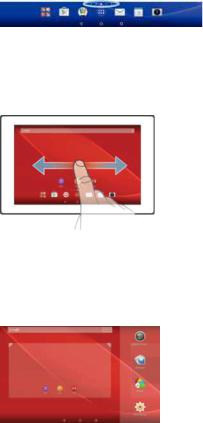
Home screen
The Homescreen is the starting point for using your device. It' s similar to the desktop on a computer screen. Your Home screen can have up to seven panes, which extend beyond the regular screen display width. The number of Home screen panes is represented by a series of dots at the lower part of the Home screen. The highlighted dot shows the pane that you are currently in.
To go to the Home screen
•Press  .
.
To browse the Home screen
Home screen panes
You can add new panes to your Home screen (up to a maximum of seven panes) and delete panes. You can also set the pane that you want to use as the main Home screen pane.
To Set a Pane as the Main Homescreen Pane
1Touch and hold an empty area on your Homescreen.
2Flick left or right to browse to the pane you want to set as your main Homescreen pane, then tap  .
.
To add a pane to your Homescreen
1Touch and hold an empty area on your Homescreen.
2To browse the panes, flick all the way to the right or left, then tap  .
.
To delete a pane from your Home screen
1Touch and hold an empty area on your Homescreen.
2Flick left or right to browse to the pane that you want to delete, then tap  .
.
Homescreen Settings
Use the Home Settings shortcut to adjust some basic settings on your Homescreen. For example, you can set your Homescreen to auto-rotate and adjust the size of icons.
To Set Your Homescreen to Auto-Rotate
1Touch and hold an empty area on your Homescreen, then tap Home Settings.
2Drag the slider beside Auto rotation to the right.
To Adjust the Size of Icons on Your Homescreen
1Touch and hold an empty area on your Homescreen, then tap Home Settings.
2Tap Icon size, then select an option.
12
This is an Internet version of this publication. © Print only for private use.

Application screen
The Application screen, which you open from the Homescreen, contains the applications that come pre-installed on your device as well as applications that you download.
|
To view all applications on the Application screen |
1 |
From your Home screen, tap . |
2 |
Flick left or right on the Application screen. |
|
To open an application from the Application screen |
• |
Flick left or right to find the application, then tap the application. |
|
To Search for an Application from the Application Screen |
1 |
When the Application screen is open, tap . |
2 |
Enter the name of the application you want to search for. |
|
To open the Application screen menu |
• |
When the Application screen is open, drag the left edge of the screen to the right. |
|
To Move an Application on the Application Screen |
1 |
To open the Application screen menu, drag the left edge of the Application screen |
2 |
to the right. |
Make sure Custom order is selected under SHOW APPS. |
|
3 |
On the Application screen, touch and hold the application until it' s selected, then |
drag it to the new location.
To Add an Application Shortcut to the Homescreen
1To open the Application screen menu, drag the left edge of the Application screen to the right.
2Make sure Custom order is selected under SHOW APPS.
3On the Application screen, touch and hold an application icon, then drag the icon to the top of the screen. The Homescreen opens.
4Drag the icon to the desired location on the Homescreen, then release your finger.
If Alphabetical or Most used is selected under SHOW APPS instead of Custom order, you can still add an application shortcut to the Homescreen. Just touch and hold the relevant application icon until the Homescreen opens, then drag the icon to the desired location and release your finger.
To arrange applications on the Application screen
1To open the Application screen menu, drag the left edge of the Application screen to the right.
2Select the desired option under SHOW APPS.
To Uninstall an Application from the Application Screen
1To open the Application screen menu, drag the left edge of the Application screen to the right.
2Tap UNINSTALL. All uninstallable applications are indicated by  .
.
3Tap the application you want to uninstall, then tap OK.
13
This is an Internet version of this publication. © Print only for private use.
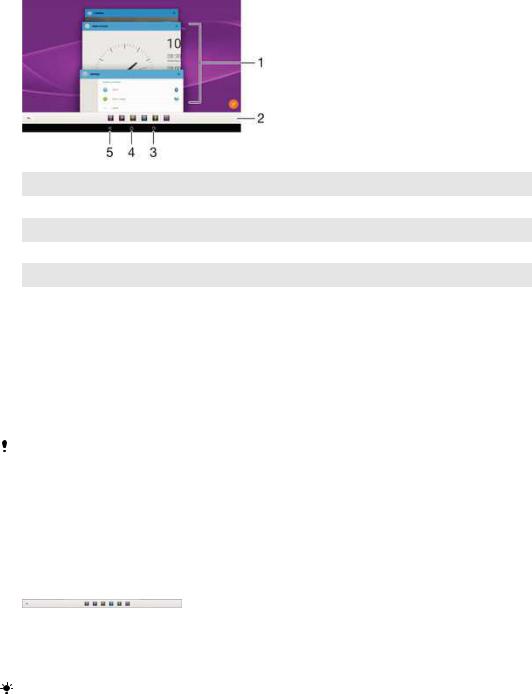
Navigating Applications
You can navigate between applications using the navigation keys, the favorites bar, and the recently used applications window, which lets you switch easily between all recently used applications. The navigation keys are the Home key, the Recent apps key, and the Back key. Some applications get closed when you press the Home key  to exit, while others are paused or continue to run in the background. If an application is paused or running in the background, you can continue where you left off the next time you open the application.
to exit, while others are paused or continue to run in the background. If an application is paused or running in the background, you can continue where you left off the next time you open the application.
1 Recently used applications window – Open a recently used application
2Favorites bar – Use a shortcut to access applications or widgets
3 Recent apps key – Open the recently used applications window and the favorites bar
4Home key – Exit an application and go back to the Homescreen
5Back key – Go back to the previous screen within an application or close the application
To open the recently used applications window
•Press  .
.
To Close All the Recently Used Applications
•Tap  and then tap
and then tap  .
.
To open a menu in an application
•While using the application, press  .
.
A menu is not available in all applications.
Small apps
Small apps are miniature apps that run on top of other applications on the same screen, to enable multi-tasking. For example, you can have a webpage open showing details of currency exchange rates, and then open the Calculator small app on top of it and perform calculations. You can access your small apps via the favorites bar. To download more small apps, go to Google Play™.
To open a small app
1To make the favorites bar appear, press  .
.
2Tap the small app that you want to open.
You can open several small apps at the same time.
To close a small app
• Tap  on the small app window.
on the small app window.
14
This is an Internet version of this publication. © Print only for private use.

To download a small app
1From the favorites bar, tap  , then tap
, then tap  and tap
and tap  .
.
2Search for the small app that you want to download, then follow the instructions to download it and complete the installation.
To move a small app
•When the small app is open, touch and hold the top left corner of the small app, then move it to the desired location.
To minimize a small app
•When the small app is open, touch and hold the top left corner of the small app, then drag it to the right edge or to the bottom edge of the screen.
To minimize a small app, you can also drag down the status bar to open the Notification panel and then tap  .
.
To rearrange the small apps in the favorites bar
•Touch and hold a small app and drag it to the desired position.
To remove a small app from the favorites bar 1 Touch and hold a small app, then drag it to .
2Tap OK.
To restore a previously removed small app
1Open the favorites bar, then tap  .
.
2Touch and hold the small app you want to restore, then drag it into the favorites bar.
To add a widget as a small app
1To make the favorites bar appear, press  .
.
2Tap  >
>  >
>  .
.
3Select a widget.
4Enter a name for the widget, if desired, then tap OK.
Widgets
Widgets are small applications that you can use directly on your Homescreen. They also function as shortcuts. For example, the Weather widget allows you to see basic weather information directly on your Homescreen. But when you tap the widget, the full Weather application opens. You can download additional widgets from Google Play™.
To Add a Widget to the Homescreen
1Touch and hold an empty area on your Homescreen, then tap Widgets & Apps.
2Find and tap the widget that you want to add.
To resize a widget
1Touch and hold a widget until it magnifies, then release the widget. If the widget can be resized, for example, the Calendar widget, then a highlighted frame and resizing dots appear.
2Drag the dots inward or outward to shrink or expand the widget.
3To confirm the new size of the widget, tap anywhere on the Homescreen.
15
This is an Internet version of this publication. © Print only for private use.
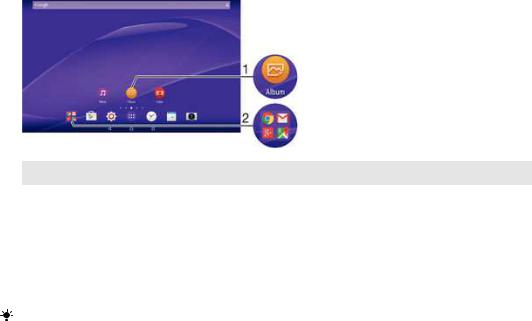
To move a widget
•Touch and hold the widget until it magnifies, then drag it to the new location.
To delete a widget
•Touch and hold the widget until it magnifies, then drag it to  .
.
Shortcuts and folders
Use shortcuts and folders to manage your applications and keep your Home screen tidy.
1 Access an application using a shortcut
2Access a folder containing applications
To Add an Application Shortcut to Your Homescreen
1Touch and hold an empty area on your Homescreen.
2In the customization menu, tap Widgets & Apps > Apps.
3Scroll through the list of applications and select an application. The selected application gets added to the Homescreen.
In step 3, alternatively, you can tap Widgets & Apps > Shortcuts and then select an application from the list available. If you use this method to add shortcuts, some of the applications available allow you to add specific functionality to the shortcut.
To Move an Item on the Homescreen
•Touch and hold the item until it is selected, then drag the item to the new location.
To Delete an Item from the Homescreen
•Touch and hold an item until it is selected, then drag the item to  .
.
To Create a Folder on the Homescreen
•Touch and hold an application icon or a shortcut until it is selected, then drag and drop it on top of another application icon or shortcut.
To Add Items to a Folder on the Homescreen
•Touch and hold an item until it is selected, then drag the item to the folder.
To rename a folder on the Home screen
1Tap the folder to open it.
2Tap the folder' s title bar to show the Folder name field.
3Enter the new folder name and tap Done.
Background and Themes
You can adapt the Homescreen to your own style using wallpapers and different themes.
16
This is an Internet version of this publication. © Print only for private use.

To change your Home screen wallpaper
1Touch and hold an empty area on your Homescreen.
2Tap Wallpapers and select an option.
To set a theme
1Touch and hold an empty area on your Homescreen.
2Tap Themes.
3Select an option and follow the instructions in your device.
When you change a theme, the background also changes in some applications.
Battery and power management
Your device has an embedded battery. You can keep track of your battery consumption and see which applications are using the most power. You can remove or restrict apps and activate a number of power saving modes to get more out of your battery. You can also view an estimate of how much battery time is left and adjust your battery settings to improve performance and make your battery last longer.
To manage your battery consumption 1 From your Homescreen, tap .
2Find and tap Settings > Power management > App power consumption. An overview appears showing applications that have high data traffic rates or that you have not used for a long time.
3Review the information, then act as required, for example, to uninstall an application or restrict its usage.
|
To view which applications use the most battery power |
1 |
From your Homescreen, tap . |
2 |
Find and tap Settings > Power management > Battery usage. |
|
To view the estimated battery time |
1 |
From your Homescreen, tap . |
2 |
Find and tap Settings > Power management. |
Power-Saving Modes
There are several power saving modes available for you to use if you want to make your battery last longer:
STAMINA mode |
Disables Wi-Fi® when the screen is turned off, and restricts hardware performance. |
|
appears in the status bar when this mode takes effect. |
Low battery mode |
Modifies your device’s behavior, for example, to adjust screen brightness and the |
|
screen timeout setting, when the battery level drops below a certain percentage. |
|
appears in the status bar when this mode takes effect. |
Queue background |
Optimizes outgoing traffic when the screen is off by sending data at pre-defined |
data |
intervals. |
If you are using a device with multiple users, you may need to log in as the owner, that is, the primary user, to activate or deactivate a power-saving mode.
17
This is an Internet version of this publication. © Print only for private use.

To Activate a Power Saving Mode 1 From your Homescreen, tap .
2Find and tap Settings > Power management .
3To activate your preferred mode, select the mode name, and tap the on-off switch to activate the chosen mode, if necessary.
STAMINA Mode Feature Overview
STAMINA mode has several features that allow you to optimize your battery performance:
Extended standby Prevents applications from using data traffic by disabling Wi-Fi® when the screen is off. You can exclude some applications and services from being paused when this feature is active.
STAMINA clock Keeps network connections paused in situations where you frequently press the power key to check the time.
Extended usage Restricts hardware performance when you are using your device.
If you are using a device with multiple users, you may need to log in as the owner, that is, the primary user, to activate or deactivate a STAMINA mode feature.
To Activate STAMINA Mode Features 1 From your Homescreen, tap .
2Find and tap Settings > Power management , then tap STAMINA mode.
3Activate STAMINA mode if it is deactivated.
4Drag the sliders beside the features you want to activate, then tap Activate, if prompted.
To select which applications to run in STAMINA mode 1 From your Homescreen, tap .
2Find and tap Settings > Power management , then tap STAMINA mode.
3Activate STAMINA mode if it is deactivated.
4Make sure the Extended standby feature is turned on, then tap Apps active in standby > Add applications.
5Scroll left or right to view all applications and services, then mark the relevant checkboxes for the applications that you want to run.
6When you' re done, tap Done.
Taking a screenshot
You can capture still images of any screen on your device as a screenshot. Screenshots you take are automatically saved in Album.
To Take a Screenshot
1Press and hold down the power key until a prompt window appears.
2Tap 
You can also take a screenshot by pressing and holding down the power key and volume down key at the same time. Once the screenshot is captured, you can release the keys.
To view your screenshot
•Drag the status bar fully downwards, then tap the screenshot you want to view.
You can also view your screenshots by opening the Album application.
Notifications
Notifications inform you of events such as new email messages and calendar notifications as well as activities in progress, such as file downloads. Notifications appear in the following places:
18
This is an Internet version of this publication. © Print only for private use.

•The status bar
•The Notification panel
•The lockscreen
To open or close the Notification panel
1To open the Notification panel, drag the status bar downward.
2To close the Notification panel, drag the panel upward.
To Take Action on a Notification in the Notification Panel
•Tap the notification.
To dismiss a notification from the Notification panel
•Place your finger on a notification and flick left or right.
To Expand a Notification on the Notification Panel
•Drag the notification downward.
Not all notifications are expandable.
To Clear all Notifications from the Notification PanelS
•Tap  .
.
To Take Action on a Notification from the Lockscreen
•Double-tap the notification.
To dismiss a notification from the lockscreen
•Place your finger on the notification and flick left or right.
To Expand a Notification on the Lockscreen
•Drag the notification downward.
Not all notifications are expandable.
Managing Notifications on the Lockscreen
You can set up your device so that only selected notifications get displayed on your lockscreen. You can make all notifications and their content accessible, hide sensitive content for all notifications or specific apps, or choose not to show any notifications at all.
To Select the Notifications to Display on the Lockscreen 1 From your Homescreen, tap .
2Find and tap Settings > Sound & notification > When device is locked.
3Select an option.
Notification Display Options on the Lockscreen
Show all notification Get all notifications on the lockscreen. When you have this setting turned on, keep in content mind that all content (including the content of incoming emails and chats) will be
visible on your lockscreen unless you designate the relevant apps as Sensitive in the
App notifications settings menu.
19
This is an Internet version of this publication. © Print only for private use.
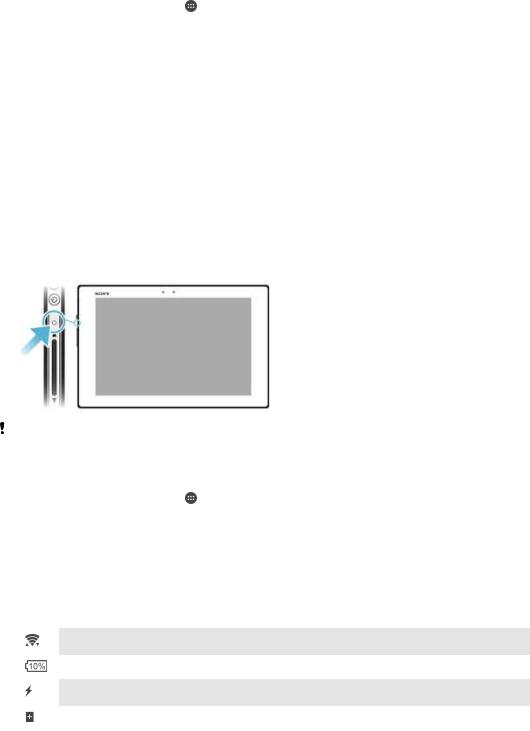
Hide sensitive |
You must have a PIN, password, or pattern set up as your screen lock in order for |
notification content |
this setting to be available. Contents hidden is displayed on the lockscreen when |
|
sensitive notifications arrive. For example, you' ll get a notification for an incoming |
|
email or chat, but the content won' t be visible on your lockscreen. |
Don't show |
You won' t get any notifications on the lockscreen. |
notifications at all |
|
Setting the Notification Level for an App
You can set different notification behaviors for individual applications. For example, you can block all email notifications, prioritize Facebook™ notifications, and make the content of messaging notifications invisible on the lockscreen.
To Set the Notification Level for an App 1 From your Homescreen, tap .
2Find and tap Settings > Sound & notification > App notifications.
3Select the app you want to change the notification settings for.
4Drag the relevant slider to the right.
Notification Levels and Options for Specific Applications
Block Never show notifications for the selected app.
Priority Show notifications for the selected apps at the top of the list on your lockscreen.
Sensitive This option is only available if you set up a PIN, password, or pattern as your screen lock and selected Show all notification content under the When device is locked setting. Notifications for
the app appear on your lockscreen but their content isn' t visible.
Notification Light
The notification light informs you about battery status and some other events. The notification light is enabled by default but can be disabled manually.
When the notification light is disabled, it only lights up when there is a battery status warning, such as when the battery level falls below 15 percent.
To Enable the Notification Light 1 From your Homescreen, tap .
2Find and tap Settings > Sound & notification.
3Drag the slider beside Notification light to the right.
Icons in the status bar
Status Icons
A Wi-Fi® connection is enabled and data is being transmitted
Battery status
The battery is charging
STAMINA mode is activated
20
This is an Internet version of this publication. © Print only for private use.

Low battery mode is activated
Airplane mode is activated
The Bluetooth® function is activated
Silent mode
Allow exceptions in silent mode
An alarm is set
GPS is activated
Synchronization is ongoing
Problem with sign-in or synchronization
Depending on your service provider and/or region, the functions or services represented by some icons in this list may not be available.
To Manage Status Bar Icons 1 From your Homescreen, tap .
2Find and tap Settings > Personalization > System icons.
3Mark the checkboxes for the system icons that you want to appear in the status bar.
Notification Icons
New email message
Downloading data
Uploading data
Perform a basic setup of your device
A software update is available
System updates are available
Downloading system updates
Tap to install the downloaded system updates
Screenshot captured
A new Hangouts™ chat message has arrived
Video chat with friends using the Hangouts™ application
Upcoming calendar event
A small app is running
Smart Connect is activated
A song is playing
The radio is playing
The device is connected to a computer via a USB cable
Internal storage is 75% full. Tap to transfer data to the memory card Warning
21
This is an Internet version of this publication. © Print only for private use.
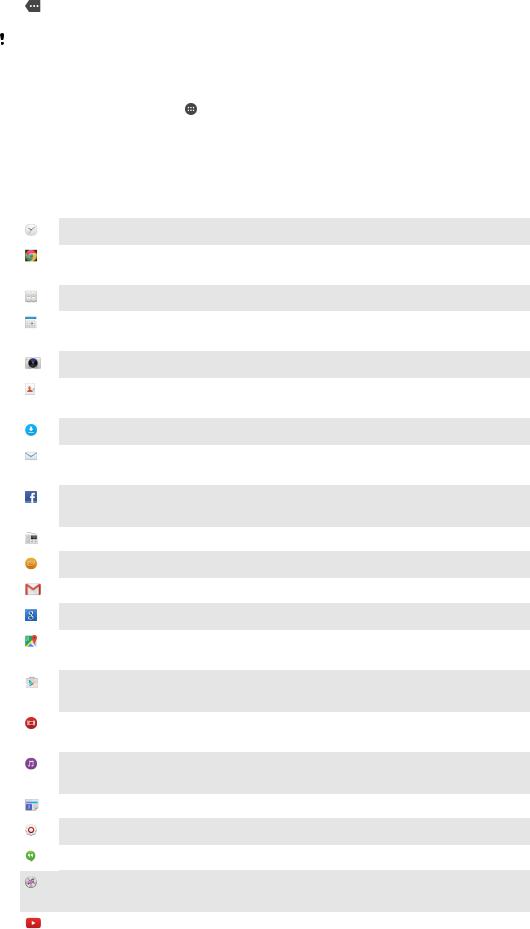
More (undisplayed) notifications
Not all icons that may appear on your device are listed here. These icons are for reference purposes only, and changes may be made without notice.
To Block an Application from Sending Notifications 1 From your Homescreen, tap .
2Find and tap Settings > Sound & notification > App notifications.
3Select an application.
4Drag the slider beside Block to the right.
Application Overview
Use the Alarm & clock application to set various kinds of alarms.
Use your web browser to navigate and view web pages and manage bookmarks, text and images.
Use the Calculator application to perform basic calculations.
Use the Calendar application to keep track of events and manage your appointments.
Use the camera to take photos and record video clips.
Use the Contacts application to manage phone numbers, email addresses, and other information related to your contacts.
Access your downloaded applications, documents and pictures.
Use the Email application to send and receive emails through both private and corporate accounts.
Use the Facebook™ application to engage in social networking with friends, family members, and coworkers around the world.
Browse and listen to FM radio stations.
Use the Album application to view and work with your photos and videos.
Use the Gmail™ application to read, write, and organize email messages.
Search for information on your device and on the web.
View your current location, find other locations, and calculate routes using Google Maps™.
Use the Play Store™ application to download free and paid applications for your device.
Use the Video application to play videos on your device and share content with your friends.
Use the Music application to organize and play music, audio books and podcasts.
View news stories and weather forecasts.
Optimize settings to suit your own requirements.
Use the Hangouts™ application to chat with friends online.
Identify music tracks that you hear playing in your surroundings, and get artist, album, and other info.
Use YouTube™ to share and view videos from around the world.
22
This is an Internet version of this publication. © Print only for private use.

Use the Backup and restore application to back up or restore content on your device, such as contacts, bookmarks, calendar data, etc.
Use the Smart Connect™ application to set what happens in your device when you connect or disconnect an accessory.
The Xperia™ Movie Creator automatically creates short videos of around 30 seconds in length using existing photos and videos. The application automatically determines the timeline to create its movie.
Use the Support application to access user support on your device. For example, you can access a User guide, troubleshooting information, plus tips and tricks.
Some applications are not supported or listed by all service providers in all areas.
23
This is an Internet version of this publication. © Print only for private use.

Downloading applications
Downloading applications from Google Play™
Google Play™ is the official online Google store for downloading applications, games, music, movies and books. It includes both free and paid applications. Before you start downloading from Google Play™, make sure that you have a working Internet connection.
To use Google Play™, you need to have a Google™ account. Google Play™ may not be available in all countries or regions.
To download an application from Google Play™ 1 From the Homescreen, tap .
2Find and tap Play Store.
3Find an item you wish to download by browsing categories, or by using the search function.
4Tap the item to view its details, and follow the instructions to complete the installation.
Some applications may need to access data, settings, and various functions on your device in order to work properly. Only install and give permissions to applications you trust.
You can view the permissions granted to a downloaded application by tapping the application under Settings > Apps.
Downloading applications from other sources
When your device is set to allow downloads from sources other than Google Play™, you can download applications directly from other websites by following the relevant download instructions.
Installing applications of unknown or unreliable origin can damage your device. Only download applications from reliable sources. Contact the application provider if you have any questions or concerns.
If you are using a device with multiple users, only the owner, that is, the primary user, can allow downloads from sources other than Google Play™. Changes made by the owner affect all other users.
To Allow the Download of Applications from Other Sources 1 From your Homescreen, tap .
2Find and tap Settings > Security.
3Drag the slider beside Unknown sources to the right.
4Tap OK.
Some applications may need to access data, settings, and various functions on your device in order to work properly. Only install and give permissions to applications you trust.
You can view the permissions granted to a downloaded application by tapping the application under Settings > Apps.
24
This is an Internet version of this publication. © Print only for private use.

Internet and networks
Browsing the web
The Google Chrome™ web browser for Android™ devices comes pre-installed in most markets. Go to http://support.google.com/chrome and click the "Chrome for Mobile" link to get more detailed information about how to use this web browser.
To browse with Google Chrome™
1From your Homescreen, tap  .
.
2Find and tap  .
.
3If you are using Google Chrome™ for the first time, select to either sign in to a Google™ account or browse with Google Chrome™ anonymously.
4Enter a search term or web address in the search and address field, then tap Go on the keyboard.
Wi-Fi®
Use Wi-Fi® connections to surf the Internet, download applications, or send and receive email. Once you have connected to a Wi-Fi® network, your device remembers the network and automatically connects to it the next time you come within range.
Some Wi-Fi® networks require you to log in to a web page before you can get access. Contact the relevant Wi-Fi® network administrator for more information.
Available Wi-Fi® networks may be open or secured:
•Open networks are indicated by  next to the Wi-Fi® network name.
next to the Wi-Fi® network name.
•Secured networks are indicated by  next to the Wi-Fi® network name.
next to the Wi-Fi® network name.
Some Wi-Fi® networks do not show up in the list of available networks because they do not broadcast their network name (SSID). If you know the network name, you can add it manually to your list of available Wi-Fi® networks.
To Turn on Wi-Fi®
1 From your Homescreen, tap .
2Find and tap Settings > Wi-Fi.
3Tap the on-off switch to turn on the Wi-Fi® function.
It may take a few seconds before Wi-Fi® is enabled.
To Connect to a Wi-Fi® Network Automatically 1 From your Homescreen, tap .
2Find and tap Settings > Wi-Fi.
3Tap the on-off switch to turn on the Wi-Fi function. All available Wi-Fi® networks are displayed.
4Tap a Wi-Fi® network to connect to it. For secured networks, enter the relevant password.  is displayed in the status bar once you are connected.
is displayed in the status bar once you are connected.
To search for new available networks, tap  , then tap Refresh. If you cannot connect to a Wi-Fi network successfully, refer to the relevant troubleshooting tips for your device at www.sonymobile.com/support/ .
, then tap Refresh. If you cannot connect to a Wi-Fi network successfully, refer to the relevant troubleshooting tips for your device at www.sonymobile.com/support/ .
25
This is an Internet version of this publication. © Print only for private use.

To Add a Wi-Fi® Network Manually 1 From your Homescreen, tap .
2Find and tap Settings > Wi-Fi.
3Tap > Add network.
4Enter the Network name (SSID) information.
5To select a security type, tap the Security field.
6If required, enter a password.
7To edit some advanced options such as proxy and IP settings, mark the Advanced options checkbox and then edit as desired.
8Tap Save.
Contact your Wi-Fi® network administrator to get the network SSID and password.
|
Wi-Fi® settings |
|
When you are connected to a Wi-Fi® network or when there are Wi-Fi® networks |
|
available in your vicinity, it is possible to view the status of these networks. You can also |
|
enable your device to notify you whenever an open Wi-Fi® network is detected. |
|
To Enable Wi-Fi® Network Notifications |
1 |
Turn on Wi-Fi® , if it is not already on. |
2 |
From your Homescreen, tap . |
3Find and tap Settings > Wi-Fi.
4Tap > Advanced.
5Drag the slider beside Network notification to the right.
To view detailed information about a connected Wi-Fi® network 1 From the Homescreen, tap .
2Find and tap Settings > Wi-Fi.
3Tap the Wi-Fi® network that you are currently connected to. Detailed network information is displayed.
Virtual private networks (VPNs)
Use your device to connect to virtual private networks (VPNs), which allow you to access resources inside a secured local network from a public network. For example, VPN connections are commonly used by corporations and educational institutions for users who need to access intranets and other internal services when they are outside of the internal network, for example, when they are traveling.
VPN connections can be set up in many ways, depending on the network. Some networks may require you to transfer and install a security certificate on your device. For detailed information on how to set up a connection to your virtual private network, please contact the network administrator of your company or organization.
To add a virtual private network 1 From your Homescreen, tap .
2Find and tap Settings > More > VPN.
3Tap  .
.
4Select the type of VPN to add.
5Enter your VPN settings.
6Tap Save.
To connect to a virtual private network
From your Homescreen, tap .
2Find and tap Settings > More > VPN.
3In the list of available networks, tap the VPN you want to connect to.
4Enter the required information.
5Tap Connect.
26
This is an Internet version of this publication. © Print only for private use.
To disconnect from a virtual private network
1Drag the status bar downwards.
2Tap the notification for the VPN connection to turn it off.
27
This is an Internet version of this publication. © Print only for private use.

Synchronizing data on your device
Synchronizing with Online Accounts
Synchronize your device with contacts, email, calendar events, and other information from online accounts, for example, email accounts such as Gmail™ and Exchange ActiveSync, Facebook™, Flickr™, and Twitter™. You can synchronize data automatically for such accounts by activating the auto-sync function. Or you can synchronize each account manually.
To Set Up an Online Account for Synchronization 1 From your Homescreen, tap .
2Tap Settings > Accounts > Add account, then select the account you want to add.
3Follow the instructions to create an account, or sign in if you already have an account.
To Synchronize Manually with an Online Account
1 From your Homescreen, tap > Settings > Accounts.
2Under Accounts, select the account type, then tap the name of the account you want to synchronize with. A list of items appears showing what can be synchronized with the account.
3Tap the items you want to synchronize.
To Remove an Online Account
1 From your Homescreen, tap > Settings > Accounts.
2Under Accounts, select the account type, then tap the name of the account you want to remove.
3Tap , then tap Remove account.
4Tap Remove account again to confirm.
Synchronizing with Microsoft® Exchange ActiveSync®
If your company uses a Microsoft Exchange ActiveSync account, you can access your
corporate email messages, calendar appointments, and contacts directly on your device. After setup, you can find your information in the Mail, Calendar and Contacts
applications.
To Set Up an EAS Account for Synchronization
1Be sure to have your domain and server details available (as provided by your corporate network administrator).
2 From your Homescreen, tap .
3Tap Settings > Accounts > Add account > Exchange ActiveSync.
4Enter your corporate email address and password.
5Tap Next. Your device begins to retrieve your account information. If a failure
occurs, enter the domain and server details for your account manually and then tap Next.
6Tap OK to allow your corporate server to control your device.
7Select what data you want to sync with your device, such as contacts and calendar entries.
8If desired, activate the device administrator to allow your corporate server to control certain security features on your device. For example, you can allow your corporate server to set password rules and set storage encryption.
9When the setup is done, enter a name for the corporate account.
When you change the login password for an EAS account on your computer, you have to log in again to the EAS account on your device.
28
This is an Internet version of this publication. © Print only for private use.

To change the settings of an EAS account 1 From your Homescreen, tap .
2Tap Mail, then tap .
3Tap Settings and select an EAS account, then change the settings of the EAS account as desired.
To set a synchronisation interval for an EAS account 1 From your Homescreen, tap .
2Tap Mail, then tap .
3Tap Settings and select an EAS account.
4Tap Check frequency > Check frequency and select an interval option.
To Remove an EAS Account
1 From your Homescreen, tap > Settings > Accounts.
2Under Accounts, tap Exchange ActiveSync, then select the EAS account you want to remove.
3Tap , then tap Remove account.
4Tap Remove account again to confirm.
Synchronizing with Outlook® using a computer
You can use the Calendar and Contacts applications within the PC Companion and the Sony Bridge for Mac computer programs to synchronize your device with the calendar and contacts from your Outlook account. However, you cannot synchronize any data from your device to your computer.
For more information on how to install the PC Companion on a PC or the Sony Bridge for Mac application on an Apple® Mac® computer, see Computer tools on the 102 page.
To synchronize with your Outlook contacts using a computer
1Be sure that the PC Companion application is installed on the PC or the Sony Bridge for Mac application is installed on the Apple® Mac® computer.
2Computer: Open the PC Companion application or the Sony Bridge for Mac application.
3Click Start to start the Contacts and Contacts Sync applications and follow the on-screen instructions to synchronize your device with your Outlook contacts.
To synchronize with your Outlook calendar using a computer
1Be sure that the PC Companion application is installed on the PC or the Sony Bridge for Mac application is installed on the Apple® Mac® computer.
2Computer: Open the PC Companion application or the Sony Bridge for Mac application.
3Click Start to start the Calendar and Calendar Sync applications and follow the on-screen instructions to synchronize your device with your Outlook calendar.
29
This is an Internet version of this publication. © Print only for private use.

|
Basic settings |
|
Accessing settings |
|
View and change settings for your device from the Settings menu. The Settings menu is |
|
accessible from both the Application screen and the Quick settings panel. |
|
To open the device settings menu from the Application screen |
1 |
From your Homescreen, tap . |
2 |
Tap Settings. |
|
To view information about your device |
1 |
From your Homescreen, tap . |
2Find and tap Settings > About tablet.
To Activate the Screen Using Tap to Wake Up Mode
1Be sure that Tap to Wake Up mode is turned on. To turn it on, tap Settings > Display, then drag the slider beside Tap to wake up to the right.
2Double-tap the screen.
To open the Quick settings panel
•Using two fingers, drag the status bar downward.
To Select which Settings to Display on the Quick Settings Panel
1Using two fingers, drag the status bar downward, then tap  .
.
2In the bar at the top of the screen, touch and hold the icon for the quick setting you want to add, then drag and drop it in the lower part of the screen.
To Rearrange the Quick Settings Panel
1Using two fingers, drag the status bar downward, then tap  .
.
2Touch and hold an icon, then move it to the desired position.
Sound Volume
You can adjust the ringtone volume for notifications as well as for music and video playback. You can set your device to silent mode and decide how long your device will be in silent mode manually. You can also preset when your device will be in silent mode automatically.
To Adjust the Media Playing Volume with the Volume Key
•When playing music or watching video, press the volume key up or down, even when the screen is locked.
To Activate Silent Mode
1Press the volume key down until  appears in the status bar.
appears in the status bar.
2Select a time interval.
Silent Mode Setting Options
Indefinitely Keep the device silent until you manually turn the sound back on.
For one hour Keep the device silent for one hour. You can tap the minus and plus icons to adjust the duration.
30
This is an Internet version of this publication. © Print only for private use.
